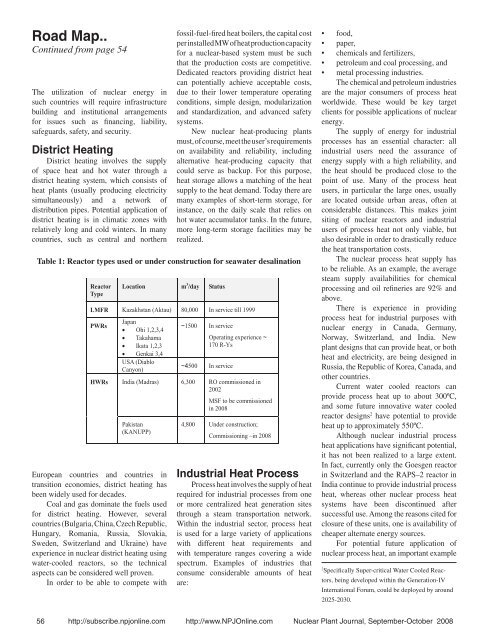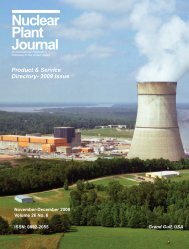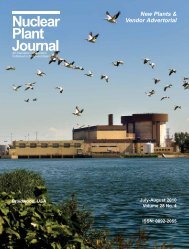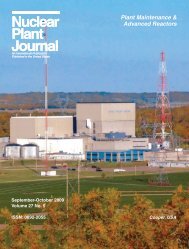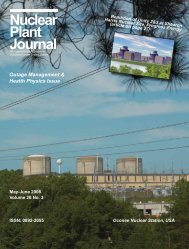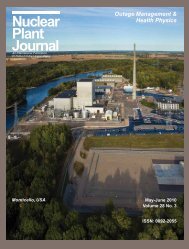Nuclear Plant Journal - Digital Versions
Nuclear Plant Journal - Digital Versions
Nuclear Plant Journal - Digital Versions
You also want an ePaper? Increase the reach of your titles
YUMPU automatically turns print PDFs into web optimized ePapers that Google loves.
Road Map..<br />
Continued from page 54<br />
The utilization of nuclear energy in<br />
such countries will require infrastructure<br />
building and institutional arrangements<br />
for issues such as financing, liability,<br />
safeguards, safety, and security.<br />
District Heating<br />
District heating involves the supply<br />
of space heat and hot water through a<br />
district heating system, which consists of<br />
heat plants (usually producing electricity<br />
simultaneously) and a network of<br />
distribution pipes. Potential application of<br />
district heating is in climatic zones with<br />
relatively long and cold winters. In many<br />
countries, such as central and northern<br />
Reactor<br />
Type<br />
European countries and countries in<br />
transition economies, district heating has<br />
been widely used for decades.<br />
Coal and gas dominate the fuels used<br />
for district heating. However, several<br />
countries (Bulgaria, China, Czech Republic,<br />
Hungary, Romania, Russia, Slovakia,<br />
Sweden, Switzerland and Ukraine) have<br />
experience in nuclear district heating using<br />
water-cooled reactors, so the technical<br />
aspects can be considered well proven.<br />
In order to be able to compete with<br />
Location m 3 /day Status<br />
fossil-fuel-fired heat boilers, the capital cost<br />
per installed MW of heat production capacity<br />
for a nuclear-based system must be such<br />
that the production costs are competitive.<br />
Dedicated reactors providing district heat<br />
can potentially achieve acceptable costs,<br />
due to their lower temperature operating<br />
conditions, simple design, modularization<br />
and standardization, and advanced safety<br />
systems.<br />
New nuclear heat-producing plants<br />
must, of course, meet the user’s requirements<br />
on availability and reliability, including<br />
alternative heat-producing capacity that<br />
could serve as backup. For this purpose,<br />
heat storage allows a matching of the heat<br />
supply to the heat demand. Today there are<br />
many examples of short-term storage, for<br />
instance, on the daily scale that relies on<br />
hot water accumulator tanks. In the future,<br />
more long-term storage facilities may be<br />
realized.<br />
Table 1: Reactor types used or under construction for seawater desalination<br />
LMFR Kazakhstan (Aktau) 80,000 In service till 1999<br />
PWRs<br />
HWRs<br />
Japan<br />
Ohi 1,2,3,4<br />
Takahama<br />
Ikata 1,2,3<br />
Genkai 3,4<br />
USA (Diablo<br />
Canyon)<br />
~1500 In service<br />
Operating experience ~<br />
170 R-Ys<br />
~4500 In service<br />
India (Madras) 6,300 RO commissioned in<br />
2002<br />
MSF to be commissioned<br />
in 2008<br />
Pakistan<br />
(KANUPP)<br />
4,800 Under construction;<br />
Commissioning –in 2008<br />
Industrial Heat Process<br />
Process heat involves the supply of heat<br />
required for industrial processes from one<br />
or more centralized heat generation sites<br />
through a steam transportation network.<br />
Within the industrial sector, process heat<br />
is used for a large variety of applications<br />
with different heat requirements and<br />
with temperature ranges covering a wide<br />
spectrum. Examples of industries that<br />
consume considerable amounts of heat<br />
are:<br />
• food,<br />
• paper,<br />
• chemicals and fertilizers,<br />
• petroleum and coal processing, and<br />
• metal processing industries.<br />
The chemical and petroleum industries<br />
are the major consumers of process heat<br />
worldwide. These would be key target<br />
clients for possible applications of nuclear<br />
energy.<br />
The supply of energy for industrial<br />
processes has an essential character: all<br />
industrial users need the assurance of<br />
energy supply with a high reliability, and<br />
the heat should be produced close to the<br />
point of use. Many of the process heat<br />
users, in particular the large ones, usually<br />
are located outside urban areas, often at<br />
considerable distances. This makes joint<br />
siting of nuclear reactors and industrial<br />
users of process heat not only viable, but<br />
also desirable in order to drastically reduce<br />
the heat transportation costs.<br />
The nuclear process heat supply has<br />
to be reliable. As an example, the average<br />
steam supply availabilities for chemical<br />
processing and oil refineries are 92% and<br />
above.<br />
There is experience in providing<br />
process heat for industrial purposes with<br />
nuclear energy in Canada, Germany,<br />
Norway, Switzerland, and India. New<br />
plant designs that can provide heat, or both<br />
heat and electricity, are being designed in<br />
Russia, the Republic of Korea, Canada, and<br />
other countries.<br />
Current water cooled reactors can<br />
provide process heat up to about 300ºC,<br />
and some future innovative water cooled<br />
reactor designs 2 have potential to provide<br />
heat up to approximately 550ºC.<br />
Although nuclear industrial process<br />
heat applications have significant potential,<br />
it has not been realized to a large extent.<br />
In fact, currently only the Goesgen reactor<br />
in Switzerland and the RAPS–2 reactor in<br />
India continue to provide industrial process<br />
heat, whereas other nuclear process heat<br />
systems have been discontinued after<br />
successful use. Among the reasons cited for<br />
closure of these units, one is availability of<br />
cheaper alternate energy sources.<br />
For potential future application of<br />
nuclear process heat, an important example<br />
2<br />
Specifically Super-critical Water Cooled Reactors,<br />
being developed within the Generation-IV<br />
International Forum, could be deployed by around<br />
2025-2030.<br />
56 http://subscribe.npjonline.com http://www.NPJOnline.com <strong>Nuclear</strong> <strong>Plant</strong> <strong>Journal</strong>, September-October 2008


